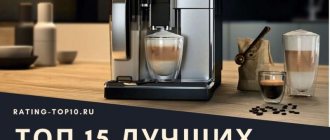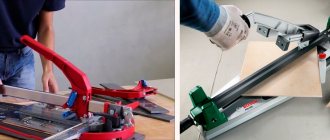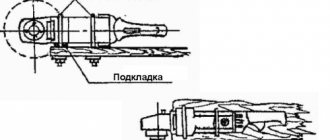The most popular finishing material for kitchens and bathrooms is ceramic tiles. To decorate a room with ceramics in a high-quality manner, a tile cutter is used. But, before cutting tiles correctly with a tile cutter, you need to know the rules of its operation. This is exactly what will be discussed in detail below.
Using a tile cutter, you can only make a straight cut through the material.
What is a tile cutter?
As the name suggests, this tool is designed for cutting tiles. In fact, it is similar in principle to working with a glass cutter - in both cases it is necessary to break the surface bonds of a fragile material in order to obtain an even fracture line.
In the case of tiles, you should cut through the surface layer of the glaze with a special cutter, and then break the product.
Essentially, a manual tile cutter is a flat piece clamp with a built-in glass cutter that moves in a straight line.
The diagram clearly shows the main parts of the desktop device:
- a platform on which the tiles are laid and which does not allow the product to break due to uneven load. All the impact from the work of the cutter is transmitted to the full plane of the tile;
- the foot, as in a sewing machine, presses the cut panel against the platform with a certain force;
- the supports hold the guides and the cutter carriage in the desired position, transmit the force from cutting the glaze to the platform, and through it to the work table;
- a carriage with a cutter, moved by the movement of the handle, cuts the product.
The photo below shows another type of design that allows you to conveniently install the panel for cutting diagonally or at a different angle.
This tile cutter from Bosch provides for the exact position of the carriage in relation to the edge of the tile, changing the angle of the cut using a square, and has side retractable supports for large-sized products.
Another useful type of device is a tile cutter with a ballerina. This device, in the form of a kind of “compass”, where a cutter is installed instead of a lead, helps to cut round holes for pipes, sockets, switches, and so on.
To simplify the marking of panels, models with a laser pointer are often used.
There is also a very simple variety - actually tongs with shock-absorbing pads on the contact planes.
Such products are used to accurately break tiles with an already cut layer of glaze. Their effectiveness is low, but the risk of uneven fracture is high.
In fact, the capabilities of a manual tile cutter, like any other tool of this type, depend more on the skill of the worker than on the functionality of the product. But it is better, of course, to choose products with additional functions - if they are needed for work.
Basic design and technological capabilities
Tile cutter is a generalized name for construction tools for straight, curved or even shaped cutting of tiles. The classification of the variety of these tools is based on the type of drive movement. So, tile cutters can be:
- Manual;
- Mechanized or electric.
A manual tile cutter consists of a base - a frame, a carriage with a roller and a handle. Its operating principle is similar to that of a regular glass cutter: a cutting roller is used to cut the glaze of the tile. At this moment it is clamped in the body like pliers. After obtaining a cut of the glaze, the tiles are broken off along it. To obtain a more even and accurate cut, guides are used that are adjusted to the tile clamping field. Sometimes tabletop manual tile cutter
An electric tile cutter is a device equipped with an electric drive that rotates a diamond cutting disc. The principle of operation of this version of the tile cutter is similar to a circular saw - the ceramic tiles move along the guide to obtain an even and neat cut. One of the varieties of mechanized tile cutter is a belt cutter, equipped with a diamond belt. To cool the tiles, water is supplied to the cutting area, which also washes away the cutting products.
In order to cut ceramic tiles correctly, you need to know how to use a tile cutter correctly .
Manual tile cutter device
A stable stamped bed with sufficiently heavy weight and rigidity along the axis of the base, which serves as a support for the tool itself, on which the tiles for cutting are laid, has a rubberized surface of the base, which eliminates the possibility of slipping during the cutting process. A frame body that is weak in strength will lead to vibration when the tiles split, which will lead to the rejection of consumables and damage to the tool itself.
The bed is firmly connected to two metal guides in which the carriage is fixed - the main working element, the components of which are:
- Lever handle. A strong handle gives more powerful leverage, which is especially valuable when working with porcelain stoneware.
- Carbide replaceable cutting wheel. The surface of the cutting roller must be of a regular round shape, without flaws, burrs or gouges. When the roller becomes dull, the cutting quality drops significantly - sharpening the cutting roller is impossible; the dull one must be replaced.
- A foot that holds the workpiece from accidentally shifting while pressing.
The guides and lever are made of durable steel and silumin, which have the necessary characteristics for the applied pressure: strength and rigidity. Additional elements are made of high quality plastic.
Some models have a scale for selecting the size of the tile; the accuracy of the size is fixed with thumbscrews (it is very convenient for left-handed people to use a tool with a mirrored double scale). The presence of a rotating ruler in professional models of tile cutters allows you to cut tiles at an arbitrary angle for shaped processing of the workpiece.
The tile cutter can be mounted on any flat, stable surface using bolted connections for ease of operation and additional rigidity when working with tiles of a sufficiently thick width - for this purpose, technological holes are provided on the bed platform.
Pros and cons of the manual model
The undoubted advantages of a manual tile cutter include:
- independence from the power grid. This device can also be used where there is no electricity or it is temporarily turned off. When working in wet areas - for example, when tiling a bathroom, swimming pool, sauna - the ability to cut tiles directly at the workplace, without going into another room with a working outlet, is very important;
- no temperature restrictions.
- Injuries when using the device are practically excluded. Maximum – damage due to accidental fall of the device on the leg or pinching of a finger;
- mobility. The products are small, even the largest options, weigh up to 1...3 kg, are easily transported and do not require special conditions of transportation and storage.
The main disadvantages are:
- the difficulty of cutting small strips along the edge of the tile. If the distance from the edge to the cut is less than 3 cm, only an experienced cutter using hand tools will be able to make an even cut;
- problems when working with tiles of non-standard sizes. Both very small and very large specimens are difficult, sometimes impossible, to cut;
- the need to exert physical effort to make the cut.
Other possible shortcomings depend rather on the specific model chosen:
- tile fracture due to excessive depreciation;
- excessive force resulting from insufficient lever length;
- insufficient size of the working area;
- uneven movement of the carriage;
- difficulty in replacing the roller (cutter) or its insufficient quality.
These points (except for the last one, it is not always possible to check the quality of the cutter in a store) should be paid attention to when purchasing.
Safety regulations
Working with a manual tile cutter is less dangerous than with an electric counterpart. After all, we don’t have to deal with vibrations, noise and a rotating disk.
Safety regulations:
- Wear a protective cover and special shoes.
- You should also wear glasses to avoid getting tile shards in your eyes.
- Cutting must be carried out in a special place (in a workshop or in a room where no one will enter during cutting).
Only an adult who has undergone safety training can cut dies. You also need to know how to provide first aid in case of injury.
Should tiles be wetted?
Many experts recommend wetting the tiles. This should be done 1-15 hours before cutting. In this way, it will be possible to soften the working material and make it more manageable. This procedure will help to obtain an even break.
Cutting towards yourself or away from yourself?
Which way should you move the carriage, towards you or away from you? Many people have this question. Some people find it more convenient to work by cutting the tiles away from themselves. Some people get a smoother furrow when cutting towards themselves.
Choose the method of cutting tiles that is more convenient and efficient for you.
Tool limitations
It is believed that a manual device of this type can only cut tiles up to 15...16 cm thick. At the same time, roller devices provide minimal cutting force, a rigid carriage provides greater impact, and only the most powerful bearing models can handle panels with a thickness of 15...16 mm.
Manual models are of little use for tiles and porcelain tiles with a relief surface. If the cutter does not reach the bottom of all the recesses, the layer of glaze will not be cut evenly. Therefore, a smooth fault cannot be expected.
With respect to porcelain stoneware, the limitation on thickness may be more serious: even bearing tile cutters do not always cope with panels with a thickness of 15...16 mm.
How to properly cut tiles with a manual tile cutter
This procedure can be performed without any problems, just follow the manufacturer’s instructions.
Sequence of operations:
- mark the cutting line. This can be done with a felt-tip pen or pencil, marker - depending on the surface of the product. For models with a laser pointer, this item can be skipped;
- The tile is fixed on the platform so that the cutting line and the wheel align as accurately as possible. If you need to make a cut diagonally or at an angle, it is convenient to use a model with a square and corner markings. If you use a simple device, without supporting corner sides, simply turn the tile into the desired position;
- by moving the carriage, an even cut is made to the end of the tile;
- lower the lever, thereby pressing on the tile on both sides of the cut. The ceramic splits along the cut line.
If the leverage is not enough, you can lay the tile on the floor, placing a narrow bar under the cut line, and simultaneously press (step on your feet, place heavy objects) on both sides of the cut.
Important: increasing the distance from the cutting line to the load application points, of course, increases the leverage and reduces the impact force. But at the same time, this increases the risk of the panel breaking not due to a cut, but arbitrarily.
As always, there are certain nuances:
- the cut is made once, it is not worth running the cutter several times in one place - the break will be uneven, with jagged edges;
- the force applied to cut the glaze must be strictly measured, as well as the force on the lever to break the panel. It is better to practice on waste or unnecessary trimmings before performing important work;
- play of the cutter (wheel) and its incomplete mobility (jamming, jerky movement) are unacceptable, the device must be adjusted and lubricated before starting work;
- Before cutting, you should check the cleanliness of the platform (presence of debris, splinters, large dust) and its stability.
Porcelain tiles should be cut according to the same principles, making allowances for the greater strength of the material. It may take more force to cut and break the panel.
In addition, a short video about exactly how a standard manual tile cutter works.
Water-cooled electric tile cutter: advantages and disadvantages
The advantages of any thing can only be assessed by comparing its capabilities with a similar product, and an electric tile cutter is no exception. Let's start in order.
- A clean, smooth, and most importantly high-precision cut without chipping the edges of the tiles - only this tool can combine all these three advantages. For example, its manual counterpart also cuts tiles evenly - the accuracy and cleanliness of the cut is questionable. In fact, a manual tile cutter does not cut, but breaks the tile smoothly - the end of the tile is by no means smooth, as the diamond blade of an electric tile cutter makes it. You ask, what about the Bulgarian? It chips the edges of the tiles - unfortunately, without water cooling of the disc it will not be possible to make a smooth, high-quality cut.
- No dust. In principle, a manual tile cutter is also dust-free, but, unlike an electric one, it does not have the above advantages.
- Possibility to make cuts at an angle. No other tile cutting tool can cope with this task. Why are such cuts needed? Have you ever seen wall corners laid at 45˚? Believe me, they look much more attractive than corners lined with special corners.
- Trimming speed. This advantage of this tool will show itself well when laying tiles in large volumes - believe me, an electric tile cutter will give odds to its manual counterpart and even an angle grinder.
How to use a tile cutter
In addition, one cannot discount the nuance that, unlike a manual tile cutter, an electric one can be used to cut segments of any shape in tiles. If you really want to, you can even cut rectangular holes in the tiles. There is also a limited ability to make curved cuts of high purity - this, however, requires practice and dexterity. And in general, with the help of an electric tile cutter you can cut even the most durable tiles. For example, some types of porcelain stoneware designed for floor use cannot be cut with any other tool.
Stationary electric tile cutter photo
Round and figured cut
The question often arises of how to cut ceramic tiles if you do not need to reduce their length/width/split diagonally or at an angle, but make a round hole.
For these purposes, a core drill or, otherwise, a diamond crown is best suited. This issue is discussed in more detail here. It is worth noting that the presence of a ballerina on a tile cutter or separately does not negate a more rational drilling option, but for the sake of one hole, of course, it is not worth buying expensive drills for tiles and porcelain stoneware. Both for working with the ballerina and for drilling, it is advisable to mark the future center of the hole. The problem of vibration is successfully eliminated by working with tiles laid on a 3...5 mm layer of water in a shape that exactly matches its dimensions.
A combination of several cuts, straight and round, will help you make a more complex cut. If the transitions of the curve along which the cut is made are sufficiently smoothed, or a broken line is used, it is convenient to use a grinder and an angle grinder with an appropriate disk.
About the tool
Tile cutter is a generalized name for a device designed to perform straight and shaped cuts on ceramic tiles. Several modifications are made:
- Hand tools - pliers (nippers) equipped with a cutting roller.
- Mechanized with manual control.
- Tile cutter with electric drive.
The power of the device is measured by the effort of one person (hand tool) up to several kilowatts for an electric drive. The last option is the professional series.
Cutting tiles with a grinder
This video shows the general principle of operation of a grinder, including grinding the edges of a fault.
However, you should understand: such filigree work requires good skill. In addition, quite often when cutting with a disk - both straight and curved - chips occur. To cut tiles with a grinder without chips and other problems, craftsmen recommend sticking masking tape along the cut line and marking it. By the way, this is convenient to do with a regular pencil.
To make work easier, it is better to fix the tiles or porcelain tiles on the work table.
This is convenient to do with special clamps. In this case, depreciation of the supporting surfaces of the clamps and at least minimal depreciation of the work table is required - this will help to avoid unwanted vibration leading to chips on the tile and its uneven fracture.
It is recommended to place polystyrene foam, polyethylene foam and other similar materials on the table.
Sometimes it is not possible to get an even cut; in this case, you can “select” the material with a grinder to a certain contour, and then smooth the edge with an abrasive.
If it is necessary to make a rectangular cutout or cut a tile along a broken contour, straight cuts are made.
Unfortunately, it is difficult to avoid cuts in the corners.
A grinder is also convenient for sanding not entirely smooth edges of tiles after cutting. For this purpose, special flexible abrasive wheels are used.
Safety rules when working with tile cutters
In order to use a manual tile cutter as safely as possible and at the same time the result of the work is of high quality, you must follow some safety rules, namely:
- Before starting work, be sure to inspect the tool you are using so that you can promptly identify all damage and unevenness of the guides, and then find and repair visible damage to the tile cutter.
- You need to walk several times while the tile is idle, and all movements should be smooth, without jolts.
- Don't forget to check the tube guides. they must be perfectly clean, free of dust and dirt. Remove the tile pieces, any traces of mortar from them and finally coat them with a little machine oil to improve performance.
- In addition, you need to pay attention to the cutting disc itself. Its condition must be ideal, in no way distorted, and rotation around the axis of the fastening must occur without any particular difficulty. It is worth noting that there should be no extraneous sounds during operation of a hand mill.
- To avoid injury, it is best to work with special glasses and gloves.
- Some experts also recommend checking the water supply to the drive, which will make it easier to work with.
- You need to start only after the disk reaches what can be called its maximum speed.
Manual tile cutter. Many people have been asking how to use it lately, but in fact there is nothing complicated in this process. Every inexperienced beginner will be able to cope with the job. If you still cannot cut out the piece of tile you need, then on our website you will find a video with the most detailed instructions that will allow you to learn all the details and nuances of this type of work. Do not forget about safety rules, because your health and, of course, safety largely depend on this.
Source
What do you need to cut tiles without a tile cutter?
In addition to the already mentioned grinder or angle grinder, glass cutters (aka wet cutters) are used. You can use them to cut tiles at home along a line of any complexity, but the problem lies in the need to apply a strictly defined (and quite large) force to make a cut and break the tile. Moreover, the more complex the cut line, the higher the risk of an uneven fracture.
It's easiest to work with straight contours.
To divide the panel, you will need to cut the tile without a tile cutter along the desired contour and carefully break it. As shown in the diagram above, a thin strip, nail, knitting needle or other similar object is placed under the fracture site. What’s interesting: you can use a glass cutter to cut over one place several times, and you also need a break line on the back of the panel. It can be sawed through with a hacksaw. Before breaking the tile, you need to “tap” the entire line, as when cutting glass, and then make a sharp break. It is convenient to rest the tile at the fracture site on the edge of the table or other corner. The fracture is cleaned with abrasive.
Another option is to use a jigsaw, regular or electric. Of course, the electric one is more productive and, due to its high cutting speed, has a lower risk of incorrectly breaking the tile.
What’s valuable is that using a jigsaw has virtually no restrictions on the thickness of the material being cut. The only limitation is the permissible immersion depth of the jigsaw blade, and in most models it is at least 3...5 cm.
For work, metal files are used, the cut is cleaned with abrasive to a smooth surface.











